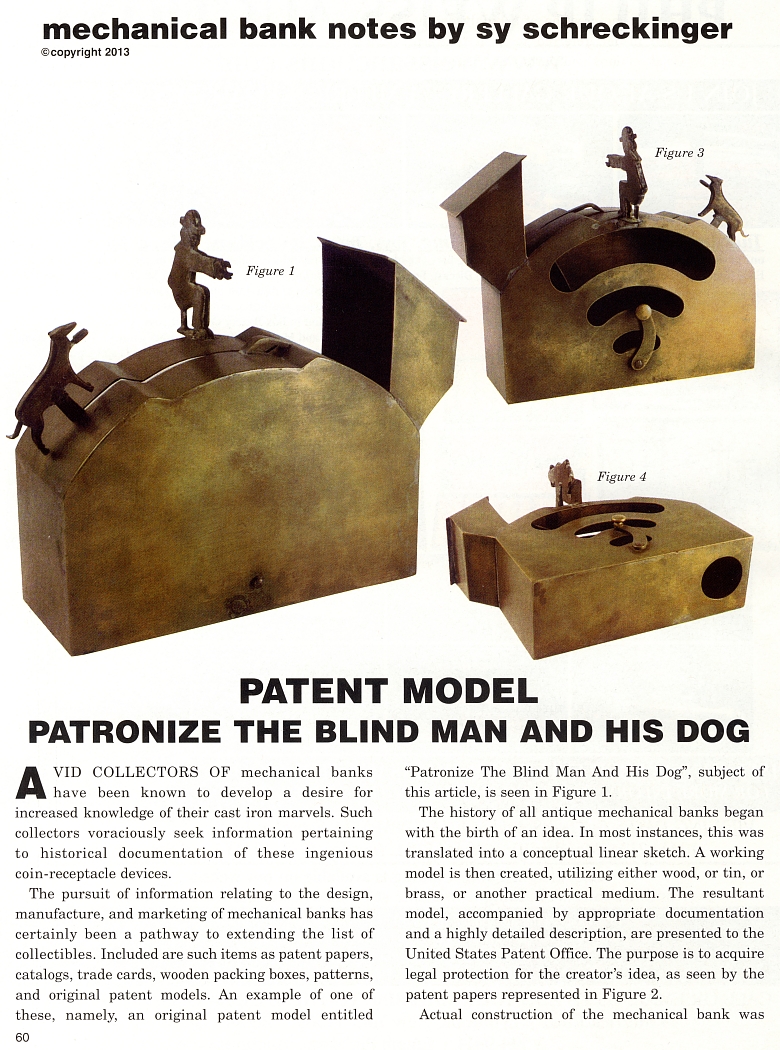|
PATENT MODEL
PATRONIZE THE BLIND MAN AND HIS DOG
by Sy Schreckinger – ANTIQUE TOY WORLD Magazine –
October, 2013
AVID
COLLECTORS OF mechanical banks have been known to develop a desire for
increased knowledge of their cast iron marvels. Such collectors
voraciously seek information pertaining to historical documentation of
these ingenious coin-receptacle devices.
The pursuit of information relating to the design, manufacture, and
marketing of mechanical banks has certainly been a pathway to extending
the list of collectibles. Included are such items as patent papers,
catalogs, trade cards, wooden packing boxes, patterns, and original
patent models. An example of one of these, namely, an original patent
model entitled "Patronize The Blind Man And His Dog", subject of this
article, is seen in Figure 1.
The history of all antique mechanical banks began with the birth of
an idea. In most instances, this was translated into a conceptual linear
sketch. A working model is then created, utilizing either wood, or tin,
or brass, or another practical medium. The resultant model, accompanied
by appropriate documentation and a highly detailed description, are
presented to the United States Patent Office. The purpose is to acquire
legal protection for the creator's idea, as seen by the patent papers
represented in Figure 2.
Actual construction of the mechanical bank was then initiated with
the creation of a highly detailed working wooden model, referred to as a
"pattern". Each of its wood sections and parts was then used to create a
sand mold. A molten lead alloy was poured into this mold to create an
exact working, lead duplicate of its wood predecessor. This lead pattern
was further re-tooled, detailed, and enhanced, Figure 5 followed by
painstaking refinements to each section. The lead pattern, having been
sufficiently prepared, was utilized in the creation of another sand mold
into which molten brass was poured.
The external details and internal mechanism of the resultant brass
model, or pattern, were further refined. It was this refined brass
duplicate that became the "master" pattern, lending its likeness and
usage to all future cast iron mechanical banks.
"Patronize The Blind Man And His Dog" was the brainchild of William
H. Lotz, a resident of Chicago, Illinois. He was granted Patent Number
200,402 for his invention and design on February 19, 1878. The
philosophical attributes of charity and thrift were clearly stated by
Mr. Lotz in these patent papers (Figure 2), as demonstrated by the
following: "F. represents the image of a kneeling man, stretching forth
his hands as if begging charity". The several views of Mr. Lotz's brass
patent model (seen in Figures 1,3,4) most aptly illustrate his initial,
idealistic concept of the embodiment of a viable, producible mechanical
bank (refer to Figures 5, 6). "Patronize The Blind Man And His Dog" was
ultimately manufactured by the J. and E. Stevens Company of Cromwell,
Connecticut. Comparison of the patent model (Figures 1, 3, 4) to the
final production bank (Figures 5, 6) indicates the Stevens Company
deviated visually, cosmetically and, to some extent, conceptually from
Mr. Lotz's patent. Interestingly, Mr. Lotz did not portray the kneeling
beggar as a blind man, as indicated by Stevens' interpretation and the
designation of its name.
Action of the working brass patent model (Figure 1) and the actual
production bank (Figures 5, 6) is ingenious and amusing. A coin is
placed between the beggar's hands; a radial arm lever attached to the
dog's body, seen in Figure 3, is nudged forward. The dog then opens its
mouth as it moves along the track, and grasps the coin held between the
beggar's hands. It then continues 0 upon its trip, depositing the money
through a void in the side of the peaked roof building. Coins are
retrieved via a small round opening in the base of the bank (Figure 4).
There are no casting variations of the "Patronize Bank"; however,
there are two color variations, as seen in Figures 5 and 6. Collectors
refer to these as the "Yellow" (Figure 5) and "Blue" (Figure 6)
variants, which pertain specifically to coloration of the name
designation tablet.
It is one quite fortunate collector who is in the enviable position
of possessing, not only the original "Patronize The Blind Man And His
Dog" Patent Model seen in Figures 1, 3, 4, but also a pristine example
of each color variant of the production bank (Figures 5, 6). No need to
guess his identity, since the aforementioned model and mechanical banks
can be viewed at the Kidd Toy Museum, Frank and Joyce Kidd Proprietors. |


